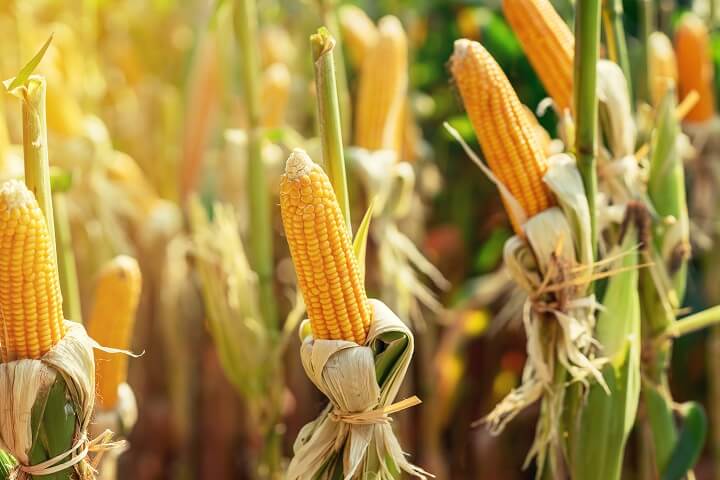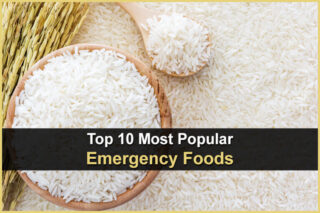
If you are looking to add a crop to your survival garden this year, corn is an excellent choice. Easy to grow, harvest and store, corn is useful in many ways around the homestead.
Let’s explore 10 reasons to grow corn this year.
1. Easy To Grow
Before briefly touching on the basics of growing corn, it's important to know there are many varieties of the plant – sweet corn, field (or dent corn), popcorn, flint corn, ornamental corn, and flour corn. We will focus on the first two since they are the ones of most use to home gardeners.
Sweet and tender, sweet corn is the variety you see in the produce section of the grocery store and at the farmer’s market. Field corn is used as livestock and poultry feed and can be dried and ground into cornmeal for human consumption.
Although most people prefer the taste of fresh sweet corn, field corn may be the best multi-purpose choice of corn for the survival garden. Or, if you have enough room to separate them from cross-pollination, you can plant both varieties.
Whatever variety you choose, be sure to select heirloom seeds. Heirloom seeds have been open-pollinated and have not been genetically modified.
Corn grows best in warm, well-drained nitrogen-rich soil. Seeds germinate best when temperatures are above 60°F.
Plant the kernels two inches deep and four to six inches apart in “blocks” that are at least four rows deep rather than in long, individual rows. The blocking method ensures that the corn—which is wind-pollinated—has a higher chance of success.

Note: If you are planting different types of corn – say sweet corn and field corn – be sure to keep them separated by at least 600 feet or cross-pollination will contaminate your crop.
If you are planting only one or two rows, you can hand pollinate. Here’s how.
- Collect pollen as soon as the silks emerge from the ears, and the tassels have a loose and appearance.
- On a morning with no breeze, shake the tassels from several plants over a dry bucket to release the pollen.
- Quickly transfer the pollen into a small paper bag.
- Then sprinkle the powder onto the silks of each ear in your corn patch.
- Repeat the process for a few days.
After planting your corn, add straw as mulch to help control weeds and to retain moisture. Corn needs plenty of moisture – about an inch of water per week (more if your soil is sandy).
Apply water at the soil level with a soaker hose or drip irrigation. Avoid spraying your plants from above, an action that can wash the pollen off the flowering tops.
2. Easy To Harvest
Sweet corn is ready to harvest after the silks appear dry and brown – anywhere from 60 to 90 days. The husk should still look green and fresh, and kernels should be filled out and round.
Peel a small portion of the husk and prick a kernel. If a milky liquid appears, the sweet corn is ready for harvesting. If the fluid is clear, give it more time, and of no liquid appears, the corn is past its prime.
Allow field corn to dry on the stalk for a while before picking it. As field corn dries, the kernels develop small dents. The appearance of these small dents means the corn is ready to harvest.
3. Easy To Store
It is essential to eat or prepare sweet corn for storage fairly quickly after harvesting. You may store freshly picked sweet corn for a short time in the fridge, but its sugars will begin converting to starch (affecting its taste) after a few days. You may freeze, dry or can fresh sweet corn.
To preserve your field corn, remove the husk and the silk. Then, you can store field corn on the cob, or you can remove the kernels and store them that way in air-tight containers. If you are making flour, you can do the grinding later as needed.
4. Nutritious and Calorie-Dense
As a survival food, corn packs a punch. The average ear of corn has 800 kernels, arranged in 16 rows. An average ear offers about 10 percent of daily values for fiber, folate, phosphorus, thiamin, Vitamin C and magnesium. One medium ear of corn (about a half-cup of kernels) provides about 100 calories and only one gram of fat.

5. Animal Feed
Throughout history, people have used corn as animal feed. Corn is a convenient and inexpensive feed for chickens and hogs. Cracking the corn through a grain mill before feeding it to your livestock helps the animals break it down better.
6. Corn Flour
You can make a versatile flour from dried whole corn kernels. When it contains the hull, germ, and endosperm of the corn, corn flour is considered a whole grain flour. You can use it in recipes for bread, muffins, waffles and incorporate it into battered and fried foods.
7. Cornmeal
Although both cornmeal and cornflour are created from milled, dried corn, the products differ in texture. Cornmeal has a gritty consistency, while corn flour is smooth. The amount of milling makes the difference, with cornflour being finely ground and cornmeal coarsely ground.
8. Recipes
Corn can be prepared and eaten in so many ways. You can roast, boil, broil, steam, grill or microwave it. You can use it to make cornbread, tortillas, and chips. You can add corn kernels to soups, salads, salsas, and stews. Here are some ideas for recipes using corn.
9. Medicine
According to the Mayo Clinic, corn’s high fiber content can aid the body’s digestive system. Corn also is a good source of the antioxidants carotenoids, lutein, and zeaxanthin.
Corn silk tea has been used for centuries to treat bladder and kidney problems. To make corn silk tea, finely chop clean corn silk. Then steep a tablespoon of the chopped corn silk in a cup of hot water for about 15 minutes. Strain out the silk before sipping the tea.
Corn silk also has some antiseptic effects and can be applied topically to promote the healing of skin irritations and minor wounds
10. Preserving Seeds
Be sure to save some of your corn seeds for re-planting (if necessary) and for next year’s crop. Allow some ears of corn to dry and mature while still on the stalks. Then allow the ears to dry some more in a barn or other protected area. Once they are completely dry, shell the corn and store the kernels in a cool, dry location.
If possible, plant corn in a different location each spring. Rotating your corn crop allows the soil time to replenish its nutrients.











My corn is already up. 36 seeds, 36 plants. I use the square foot method.
You’re right that corn is an excellent food crop. I plant a variety of flint corn since it is hardy for my area (New Hampshire). As for the grinding into meal or flour, I also add the nixtamalization process (soaking in a lye water) to make hominy. Rather than fill your comments section with the how-to, I did a blog post about the process a while back. mic-roland.com/ancient-survival-food-hominy/
— Mic
Thanks, Great advice!